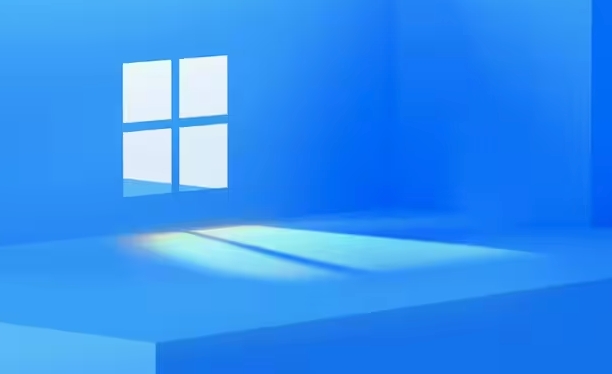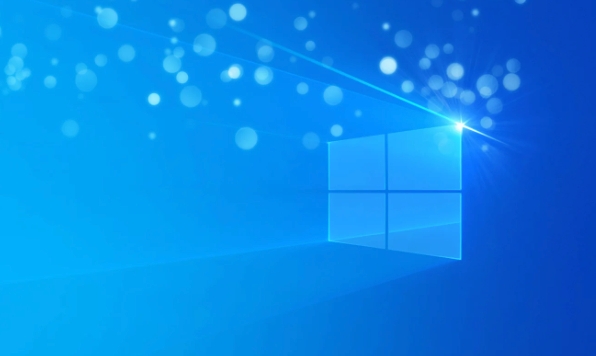Why is my Windows PC not connecting to Wi-Fi
Jul 07, 2025 am 02:28 AMYour Windows PC might not connect to Wi-Fi due to signal issues, driver problems, or network settings. 1. Check basics like Wi-Fi toggle, router status, and other devices’ connectivity. 2. Restart your PC and router. 3. Inspect network adapters via Device Manager for driver issues and update or reinstall them if needed. 4. Forget the network in settings and reconnect with the correct password. 5. Run the built-in network troubleshooter. 6. Use Command Prompt to release and renew IP address and reset TCP/IP. 7. Temporarily disable firewalls or antivirus tools that may block connections. 8. Adjust router Wi-Fi channel to avoid interference. 9. Ensure hardware supports current Wi-Fi standards and is undamaged. Following these steps should resolve most connection issues.

Your Windows PC might not be connecting to Wi-Fi due to a variety of reasons, ranging from simple signal issues to more technical problems like driver conflicts or network settings. Before jumping into complicated fixes, start by checking the basics—like whether Wi-Fi is actually turned on and if other devices can connect to the same network.

Check Your Wi-Fi Connection Basics
Before diving into advanced troubleshooting, rule out the most obvious causes. Sometimes the issue is as simple as a misconfigured setting or a router that’s temporarily down.

- Make sure your Wi-Fi is enabled. On laptops, there's often a function key (like Fn F2 or another F key) to toggle it on or off.
- Restart both your PC and your router. This clears temporary glitches in both devices.
- Check if other devices can connect to the same Wi-Fi. If they can’t, the problem may lie with your internet service or router, not your PC.
If everything looks fine on the hardware side and only your PC has trouble, move on to software-related checks.
Look at Network Adapter and Driver Issues
Windows relies on drivers to communicate with your PC’s hardware, including the Wi-Fi adapter. Outdated, missing, or corrupted drivers are common culprits when you can't connect.

You can check the status of your network adapters through Device Manager:
- Press
Win Xand select Device Manager. - Expand Network adapters and look for any yellow exclamation marks.
- Right-click the wireless adapter and choose Update driver.
- Alternatively, you can uninstall the driver and let Windows reinstall it automatically after a restart.
Also, make sure the Wi-Fi adapter isn’t disabled in Device Manager or through power-saving settings. Some systems turn it off to save energy when not in use.
Review Network Settings and Profiles
Sometimes Windows saves network profiles that become outdated or conflicting, especially if you've connected and disconnected multiple times or changed routers.
Try these steps:
- Go to Settings > Network & Internet > Wi-Fi, then click Manage known networks.
- Select your network and click Forget.
- Reconnect by selecting the network again and entering the password.
If that doesn’t work, run the built-in network troubleshooter:
- Go to Settings > System > Troubleshoot.
- Run the Internet Connections troubleshooter to detect and fix issues automatically.
In some cases, manually resetting TCP/IP or renewing your IP address via Command Prompt can also help:
- Open Command Prompt as administrator.
- Type
ipconfig /releaseand press Enter. - Then type
ipconfig /renewand press Enter. - Follow up with
netsh winsock resetandnetsh int ip reset.
Watch for Common Hidden Traps
Some issues aren’t immediately obvious. For example, certain security software or firewall settings can block connections without clear warnings. Try temporarily disabling third-party antivirus or firewall tools to see if that resolves the issue.
Another sneaky problem: channel interference. If you're in an apartment or crowded area, many nearby Wi-Fi networks might be using the same channel, causing instability. You can change your router’s Wi-Fi channel through its admin panel, usually accessible via a browser.
Also, don’t overlook physical damage or compatibility issues. Older PCs might struggle with newer Wi-Fi standards like Wi-Fi 6 unless the adapter supports them.
That’s about it. There are several layers to this problem, but most of the time, one of these steps should get you back online.
The above is the detailed content of Why is my Windows PC not connecting to Wi-Fi. For more information, please follow other related articles on the PHP Chinese website!

Hot AI Tools

Undress AI Tool
Undress images for free

Undresser.AI Undress
AI-powered app for creating realistic nude photos

AI Clothes Remover
Online AI tool for removing clothes from photos.

Clothoff.io
AI clothes remover

Video Face Swap
Swap faces in any video effortlessly with our completely free AI face swap tool!

Hot Article

Hot Tools

Notepad++7.3.1
Easy-to-use and free code editor

SublimeText3 Chinese version
Chinese version, very easy to use

Zend Studio 13.0.1
Powerful PHP integrated development environment

Dreamweaver CS6
Visual web development tools

SublimeText3 Mac version
God-level code editing software (SublimeText3)

Hot Topics
 Windows can't access shared folder on network
Jun 30, 2025 pm 04:56 PM
Windows can't access shared folder on network
Jun 30, 2025 pm 04:56 PM
When encountering the "Windowscan'taccesssharedfolderonnetwork", you can usually solve the problem through the following steps: 1. Turn on the network discovery and file sharing function and turn off password protection; 2. Make sure that the target computer is enabled to share and set the correct permissions; 3. Check the firewall rules and service status to ensure that it allows shared access; 4. Use the credential manager to add network credentials for long-term and stable connection.
 Windows 'Getting Windows ready, Don't turn off your computer' stuck
Jun 30, 2025 pm 05:18 PM
Windows 'Getting Windows ready, Don't turn off your computer' stuck
Jun 30, 2025 pm 05:18 PM
When you encounter Windows stuck in the "GettingWindowsready, Don't turnoff your computer" interface, you should first confirm whether it is really stuck; 1. Observe whether the hard disk indicator light is flashing, 2. Check whether the fan sound has changed, 3. Wait at least 30 to 60 minutes to ensure that the system has enough time to complete the update operation.
 How to run an app as an administrator in Windows?
Jul 01, 2025 am 01:05 AM
How to run an app as an administrator in Windows?
Jul 01, 2025 am 01:05 AM
To run programs as administrator, you can use Windows' own functions: 1. Right-click the menu to select "Run as administrator", which is suitable for temporary privilege hike scenarios; 2. Create a shortcut and check "Run as administrator" to achieve automatic privilege hike start; 3. Use the task scheduler to configure automated tasks, suitable for running programs that require permissions on a scheduled or background basis, pay attention to setting details such as path changes and permission checks.
 Windows clipboard history not working
Jun 30, 2025 pm 05:14 PM
Windows clipboard history not working
Jun 30, 2025 pm 05:14 PM
When the Windows clipboard history is not working, you can check the following steps: 1. Confirm that the clipboard history function is enabled, the path is "Settings>System>Clipboard", and if it is not enabled, Win V will not respond; 2. Check whether the copy content type is limited, such as large images, special formats or file paths may not be saved; 3. Ensure that the system version supports it, Windows 101809 and above, and some enterprise versions or LTSC do not support it; 4. Try to restart the ClipboardUserService service or end the clipups.exe process; 5. Clear the clipboard cache or reset the settings, close and then turn on the "Clipboard History" or run the "echooff|clip" command to clean up the cache
 How to fix a stuck Windows restart screen?
Jun 30, 2025 pm 05:10 PM
How to fix a stuck Windows restart screen?
Jun 30, 2025 pm 05:10 PM
Don't rush to reinstall the system when the computer is stuck in the Windows restart interface. You can try the following methods first: 1. Force shutdown and then restart. Apply to the situation where the update is stuck. Repeat two or three times or can skip the lag; 2. Enter the safe mode to check, select Start repair or system restore through troubleshooting. If you can enter safe mode, it may be a driver or software conflict; 3. Use the command prompt to repair the system files, enter the three commands sfc and dism in the recovery environment to repair the damaged files; 4. Check the recently installed hardware or driver, unplug the non-essential devices or uninstall the new driver to eliminate incompatibility issues. In most cases, the above steps can solve the phenomenon of restart lag. If it really doesn’t work, consider reinstalling the system and paying attention to backing up data in advance.
 Windows stuck on 'undoing changes made to your computer'
Jul 05, 2025 am 02:51 AM
Windows stuck on 'undoing changes made to your computer'
Jul 05, 2025 am 02:51 AM
The computer is stuck in the "Undo Changes made to the computer" interface, which is a common problem after the Windows update fails. It is usually caused by the stuck rollback process and cannot enter the system normally. 1. First of all, you should wait patiently for a long enough time, especially after restarting, it may take more than 30 minutes to complete the rollback, and observe the hard disk light to determine whether it is still running. 2. If there is no progress for a long time, you can force shut down and enter the recovery environment (WinRE) multiple times, and try to start repair or system restore. 3. After entering safe mode, you can uninstall the most recent update records through the control panel. 4. Use the command prompt to execute the bootrec command in the recovery environment to repair the boot file, or run sfc/scannow to check the system file. 5. The last method is to use the "Reset this computer" function
 How to fix SYSTEM_SERVICE_EXCEPTION on Windows?
Jun 30, 2025 pm 05:11 PM
How to fix SYSTEM_SERVICE_EXCEPTION on Windows?
Jun 30, 2025 pm 05:11 PM
When encountering SYSTEM\_SERVICE\_EXCEPTION error, 1. Update or roll back the graphics card driver, try to update the driver with the device manager, download and install the official website, or use DDU to completely uninstall and reinstall; 2. Check the memory stick, detect abnormalities through the task manager and Windows memory diagnostic tool, and clean the memory stick or change the slot test if necessary; 3. Repair the system files, run the sfc/scannow and DISM commands with administrator permissions, and check Windows Update; 4. Uninstall recently installed software or updates, especially antivirus software or virtual machine tools. If the above method is invalid, it may be a hardware problem that needs further detection.
 How to fix a corrupted user profile in Windows?
Jun 30, 2025 pm 05:11 PM
How to fix a corrupted user profile in Windows?
Jun 30, 2025 pm 05:11 PM
Corruption of user profile can be solved by creating a new account, using system tools to repair, manually migrating data, and modifying the registry. After confirming the problem, you can try the following methods in turn: 1. Create a new local account to determine whether it is the original account problem; 2. Use sfc/scannow and DISM tools to repair the system files; 3. Create a new user through the administrator account and manually migrate the old account files (including the hidden AppData directory); 4. Advanced users can try to locate the ProfileList item in the registry editor, check and repair the abnormal ProfileImagePath entry, and backup the registry before the operation.






